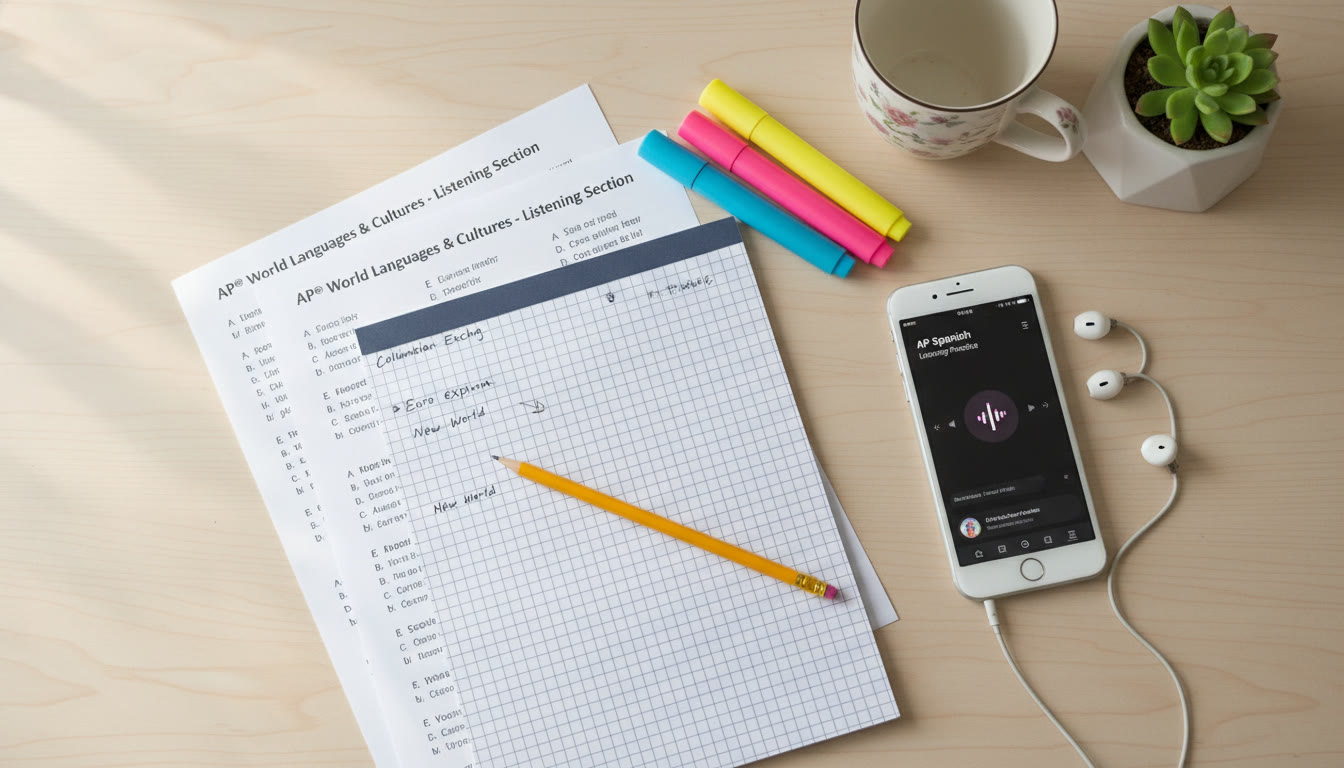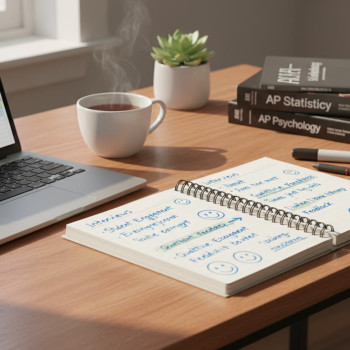Why Listening Sections Feel Different (And Why That’s Okay)
If you’ve ever sat down for an AP listening component—especially AP Spanish Language and Culture or AP Spanish Literature and Culture—you know that mixture of nerves and adrenaline: the headphones go on, the narrator begins, and suddenly three minutes can feel like thirty. Listening sections are unique because they’re transient: you hear once (or twice), and you must make sense of meaning, purpose, and detail in real time. But that moment can be turned into opportunity. With the right anticipation techniques and a battle-tested note grid, you’ll move from guessing to decoding—and from anxious to confident.

Anticipation: The Secret Ingredient
Anticipation is not psychic power. It’s preparation. Before the audio starts, you have the advantage of preview time: brief seconds to scan questions and options, and to form expectations. That preview is gold. It primes your ear, focuses attention on keywords or transitions, and reduces the jittery “what just happened?” moment after the clip ends.
What to do during the preview
- Read all questions quickly—look for question type (main idea, detail, speaker attitude, inference).
- Underline or circle connective words and time markers in the questions (e.g., sin embargo, mientras tanto, luego).
- Predict: ask yourself, “What kind of answer would satisfy this question?” A short factual date? A comparative opinion? A solution to a problem?
- Assign mental priorities: mark the question you’ll answer first (often a main-idea question) and which ones depend on a small detail.
When you preview, you’re building a mental map: you’ll listen for the route the speaker will take and the landmarks (names, times, reasons, contrasts). Even if the audio surprises you, that map reduces the cognitive load and speeds recovery.
Note Grids: Organized Notes for Chaotic Audio
Random scribbles rarely help. A note grid is a small, structured table you create before or during the recording to capture essential categories: Who, What, Where, When, Why/How, Tone, and Key Words. The grid intentionally compresses information into predictable boxes so you can grab and go—no time wasted thinking about how to record an idea.
Why grids work
- They create expectations—so you listen with a purpose.
- They force economy—short phrases and symbols beat full sentences.
- They make review lightning-fast—your eyes scan boxes instead of decoding paragraphs.
How to build your standard note grid
Create a compact grid that fits the space the exam provides (or reproduce it on practice sheets). Use shorthand and symbols you can read in a flash. Here’s a simple grid you can adapt based on the question types you encounter.
| Box | What to Put | Shorthand Examples |
|---|---|---|
| Who | Main speakers, relationships | M=maestro, E=estudiante, P=padre |
| What | Main action or topic | evento, opinión, instrucción |
| Where/When | Location and time markers | escuela, hoy, mañana, 8pm |
| Why/How | Purpose, cause, method | porque, para, debido a |
| Tone/Attitude | Humor, sarcasm, frustration | irónico, serio, entusiasmado |
| Keywords | Names, numbers, repeated terms | — |
| Q Link | Question numbers tied to the audio | Q1: main idea, Q2: detalle |
Practice filling this grid until it’s almost reflexive. You’ll be amazed how much you can capture with three to five words per box.
Real-World Example: Turning an Interview Into Answers
Picture a 60-second interview: a university official explains a new campus policy. The preview questions ask: (1) Why was the policy introduced? (main idea), (2) Who is affected? (detail), (3) What’s the official’s attitude? (tone), (4) What is the timeline? (detail).
During the preview you spot keywords: policy, students, safety, next semester. You sketch your grid:
- Who — admin, students
- What — policy for campus safety
- Where/When — campus, next sem
- Why/How — increase safety after incidents
- Tone — apologetic but firm
- Keywords — seguridad, incidentes, fecha
When the audio plays, you don’t write full sentences; you add small details: “incidentes = 3 last month,” “new IDs,” “start Aug.” That’s all you need to answer the four questions quickly and accurately.
Shorthand and Symbols: Your Time-Saving Language
Shortcuts make the difference between capturing and missing a detail. Here are symbols and shorthand conventions students often use (pick what sticks and stay consistent):
- > means causes/ leads to
- < means reduces
- + and – for pros/cons
- NB for notable
- TP for turning point
- Q1, Q2 to link grid boxes to questions
Tip: Write numbers as numerals and abbreviate months or long words (ej. “seg.” for seguridad) so you’re not rewriting the whole sentence you just heard.
Practice Routines That Work (Not Just Time Spent)
Practice must be deliberate. Two hours of distracted listening is worth less than thirty focused minutes with reflection. Here’s a weekly routine you can follow in the six weeks before the exam.
| Week | Focus | Daily Task |
|---|---|---|
| Week 1 | Previewing habits | Scan questions before audio; practice one grid per clip (20–30 min/day) |
| Week 2 | Shorthand & symbols | Use only shorthand in notes; transcribe afterward to check accuracy (30–40 min/day) |
| Week 3 | Tone & inference | Practice identifying speaker attitude and implied meaning (30 min/day) |
| Week 4 | Timed sections | Simulate exam timing and audio playback rules (55 min practice sessions) |
| Week 5 | Mixed question sets | Full listening sections with mixed audio; focus on review of wrong answers (60 min/day) |
| Week 6 | Polish and calm | Light practice, review grids, sleep and test-day strategy (30 min/day) |
During these weeks, vary content: interviews, podcasts, instructions, announcements, and short stories. Authentic, real-world audio makes the listening patterns obvious and builds resilience. If you have access to tailored tutoring—like Sparkl’s personalized tutoring—this is the time to get 1-on-1 guidance to focus on weak spots and build a study plan designed for your rhythm.
Question Types and How Your Grid Handles Them
Different question types demand different information. Below are common types and how to capture exactly what you need quickly.
Main Idea
Listen for summary phrases or thesis statements. Put a star in your grid’s “What” box and jot a single sentence paraphrase—three to seven words. Often this is what the speaker repeats or frames at the beginning or end.
Specific Detail
These are numbers, names, dates, or locations. Capture them verbatim when possible. Use the “Keywords” box as your quick storehouse and place an arrow linking it to the question number.
Inference
Inferences need tone and context. Check your Tone/Attitude box and the Why/How box. A phrase like “no parece” or a laugh could tip you off to irony—record it.
Function/Purpose
Why is the speaker giving this info? Policy announcement? Apology? Instruction? Use the “Why/How” box and write purpose first, then supporting detail.
Test-Day Tactics: Calm, Clear, Controlled
On exam day, small rituals keep your mind steady. Below are simple, high-impact tactics:
- Bring a clean pencil that’s easy to erase—notes are dynamic.
- Use the preview time: don’t waste it rereading. Use it to set a plan.
- Mark the toughest question to revisit—don’t stall on it during the audio.
- If you miss a detail the first time, look for corroborating clues later—speakers often repeat or rephrase key facts.
- Breathe. If panic starts, take two slow breaths and refocus on the grid boxes. Panic erases working memory; breathing restores it.
How to Review Practice Mistakes (The Right Way)
When a practiced listening set produces errors, do a focused post-mortem. Don’t just mark wrong and move on—dissect.
- Re-listen: Where did you lose the thread? Was it vocabulary or flow?
- Check the grid: Did you miss a box or misread your shorthand?
- Identify patterns: Are you missing dates, or do inference questions trip you? Adjust practice accordingly.
- Recreate the preview: Would a better initial prediction have helped? Practice improving preview questions.
Keep an error log. After two weeks, review the log to see if mistakes repeat. If they do, that’s the exact area you should drill next.
Example Note Grid Filled Out (Short Transcript)
Below is a condensed example showing how an actual 40–60 second conversation could be captured in a grid, then turned into answers.
| Grid Box | Notes |
|---|---|
| Who | Prof (P), Student (S) |
| What | P: explains change in office hrs; S: concerned |
| Where/When | Dept office; starting Mon (next wk) |
| Why/How | Reduce crowding after safety incident; sign-up system |
| Tone | Reassuring, apologetic |
| Keywords | incidente, turno, registro, lunes |
| Q Link | Q1 main idea, Q2 what change, Q3 why, Q4 tone |
From these compact notes you can answer each question quickly. That’s the point: fewer words, faster recall.
Using Technology and Tutoring Wisely
In the digital age, you have two powerful allies: targeted practice materials and personalized coaching. Technology can provide authentic audio at variable speeds, and a smart tutor helps you interpret mistakes. If you consider a tutoring option like Sparkl’s personalized tutoring, prioritize sessions that give immediate, actionable feedback: have the tutor listen to your grids, point out recurring shorthand confusions, and help you build a customized practice plan. That 1-on-1 guidance often shortens the improvement curve significantly—especially when it pairs expert tutors with data-driven insights to show where you improve most quickly.
Common Pitfalls—and How to Avoid Them
- Writing full sentences: Keep phrases short. You don’t have time for elegance, only clarity.
- Ignoring preview time: If you don’t use it, you’re flying blind.
- Over-relying on memory: Write the detail. Trust the page, not your head.
- Being inconsistent with shorthand: Choose a small set of symbols and stick with them.
- Not simulating test conditions: Practice under full timing, with the same number of plays allowed.
Motivation and Mindset: The Listening Mind
Listening well is as much about attitude as technique. Approach the audio with curiosity, not dread. Think of each clip as a short story or puzzle you get to solve. That playful mindset reduces anxiety and improves focus. Celebrate small wins: a single question you nailed because your grid captured the right word is progress worth noting.
A short pep talk
You’ve practiced. You know your shorthand. You’ve built a grid that fits your brain. On test day, the audio won’t be a trap—it will be a stage. Step onto it with the quiet confidence of someone who has prepared deliberately. If you feel jittery during the clip, remember your grid. Every box is a lifeline back to meaning.
Wrap-Up: A Simple Checklist Before the Exam
- Pencil and eraser ready, and a practiced shorthand list at hand.
- Grid template practiced until reflexive.
- Preview strategy practiced: read, predict, prioritize.
- One calm breathing technique to reset if panic starts.
- At least two full timed practice sections completed within the last week.

Final Thoughts
Listening sections reward preparation that is structured, deliberate, and calm. Anticipation narrows the field of possibilities, while the note grid captures the moments you’d otherwise lose. Combine those with targeted practice—especially guided sessions that point out patterns in your mistakes—and you’ll transform listening from a weakness into a reliable strength. If you choose to bring in personalized tutoring like Sparkl’s, use it to sharpen your preview skills, refine your shorthand, and create a study plan tailored to your current level. That kind of focused help can be the difference between guessing and answering with confidence.
So breathe, build a grid you trust, and treat each audio clip as a short challenge you’re ready to decode. The sound will pass—and your notes will still be there to guide you to the right answer.
Ready to practice?
Start small: one audio clip, one grid, one review. Gradually build whether you have six weeks or six days. The strategy is the same: anticipate, capture, and reflect. You’ve got this.





















No Comments
Leave a comment Cancel